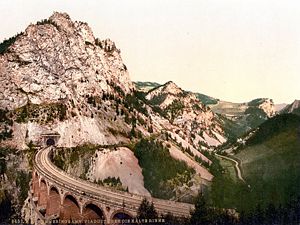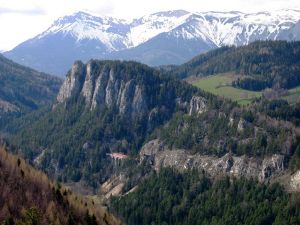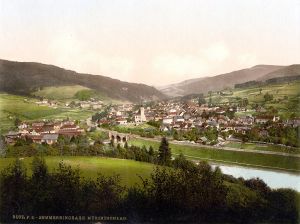Semmering Railway
| Semmering Railway* | |
|---|---|
| UNESCO World Heritage Site | |

| |
| State Party | |
| Type | Cultural |
| Criteria | ii, iv |
| Reference | 785 |
| Region** | Europe |
| Inscription history | |
| Inscription | 1998 (22nd Session) |
| * Name as inscribed on World Heritage List. ** Region as classified by UNESCO. | |
The Semmering Railway, Austria, which starts at Gloggnitz and leads over the Semmering to Mürzzuschlag was the first mountain railway in Europe built with a standard gauge track. It is commonly referred to as the world's first true mountain railway, given the very difficult terrain and the considerable altitude difference that was mastered during its construction. It is still fully functional as a part of the Austrian Southern Railway.
History
The Semmering Railway was constructed between 1848 and 1854 by some 20,000 workers under the project's designer and director Carl von Ghega. The construction features 14 tunnels (among them the 1,431 m vertex tunnel), 16 viaducts (several two-story) and over 100 curved stone bridges as well as 11 small iron bridges. The stations and the buildings for the supervisors were often built directly from the waste material produced in the course of tunnel construction.
Across an overall track length of 41 km the Semmering Railway masters an altitude difference of 460 m; on 60% of its length the steepness is 20-25‰ (equivalent to a 1-meter difference in altitude on a 40 m route distance), and 16% exhibit a curvature radius of only 190 m. This was an entirely new technical dimension of railway construction, and new instruments and methods of surveying had to be developed to handle the resulting challenges. Also, new technologies were employed for the Engerth locomotives because the types in general use at this time could not handle the extreme gradients and turning radii.
Even while being built the Semmering Railway was perceived as an effort of "landscape gardening", i.e. it attempted a harmonious combination of technology and nature. The unique travel experience which the Semmering Railway offered contributed significantly to the original opening of the Semmering region for tourism. Numerous hotels and mansions are witnesses of this epoch. This enormous upswing to the turn of the century and the revaluation of the region as a winter sports area in the first third of the 20th Century were interrupted first by World War I and then by the changed recreational needs of the population. Therefore this unique culture landscape could be preserved with little change. A trip on the Semmering Railway, which is in full use 150 years after its building, still impresses the traveller as a special experience by its varied landscape, the typical style of its mansions and the characteristic sequence of viaducts and tunnel constructions.
In 1998 the Semmering Railway was added to the list of the UNESCO World Heritage sites.
The Railway in numismatics
The Semmering Alpine Railway has been the main motive for may collector coins and medals. One of the most famous and recent ones is the 150 Years Semmering Alpine Railway Coin. The obverse shows two locomotives: a historical and a modern one. The reverse of the coin shows a typical Semmering view. An Engerth steam locomotive just emerged from a tunnel crossing one of the distinctive viaducts.
See also
- Culture of Austria
External links
Credits
New World Encyclopedia writers and editors rewrote and completed the Wikipedia article in accordance with New World Encyclopedia standards. This article abides by terms of the Creative Commons CC-by-sa 3.0 License (CC-by-sa), which may be used and disseminated with proper attribution. Credit is due under the terms of this license that can reference both the New World Encyclopedia contributors and the selfless volunteer contributors of the Wikimedia Foundation. To cite this article click here for a list of acceptable citing formats.The history of earlier contributions by wikipedians is accessible to researchers here:
The history of this article since it was imported to New World Encyclopedia:
Note: Some restrictions may apply to use of individual images which are separately licensed.

